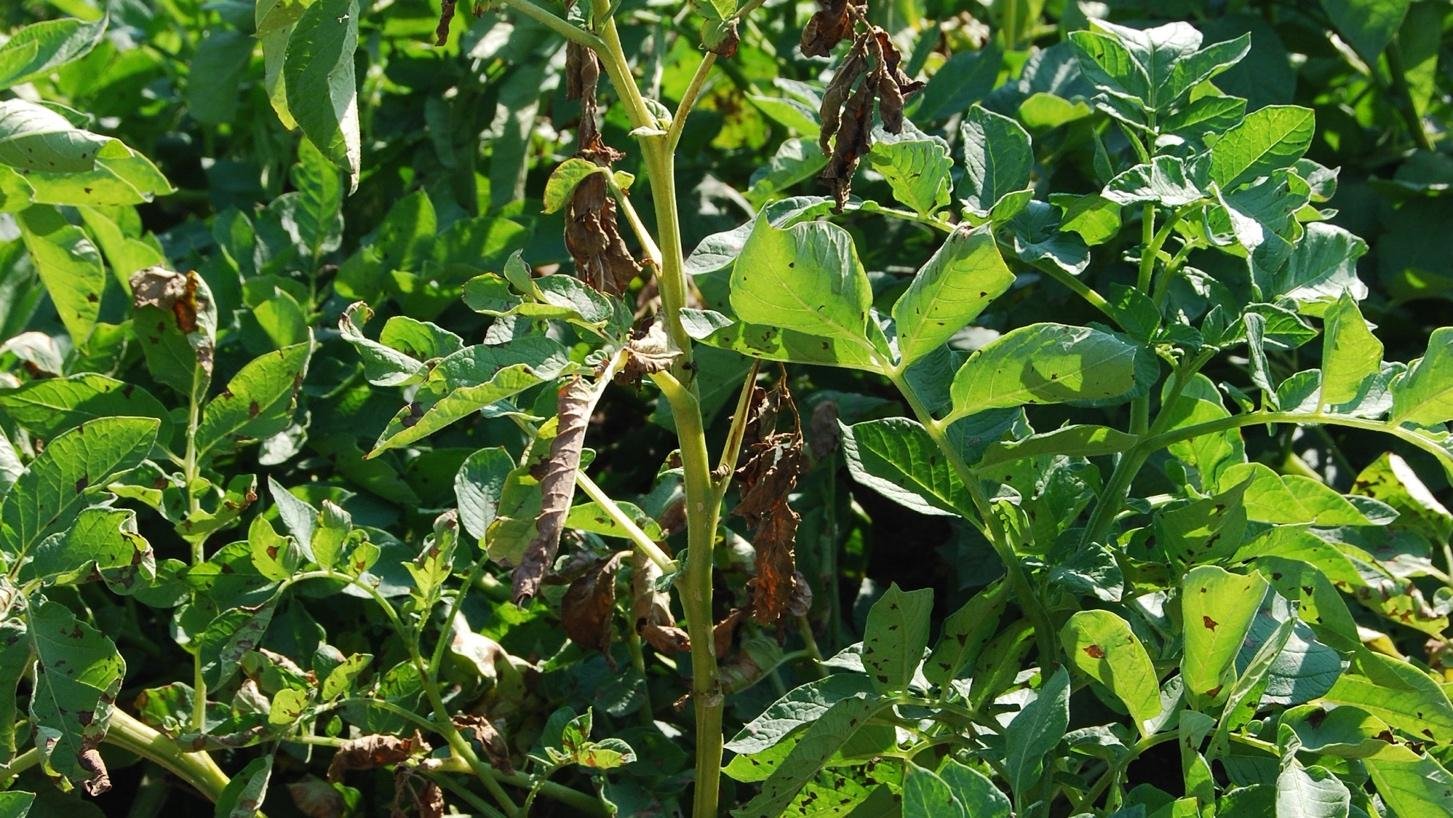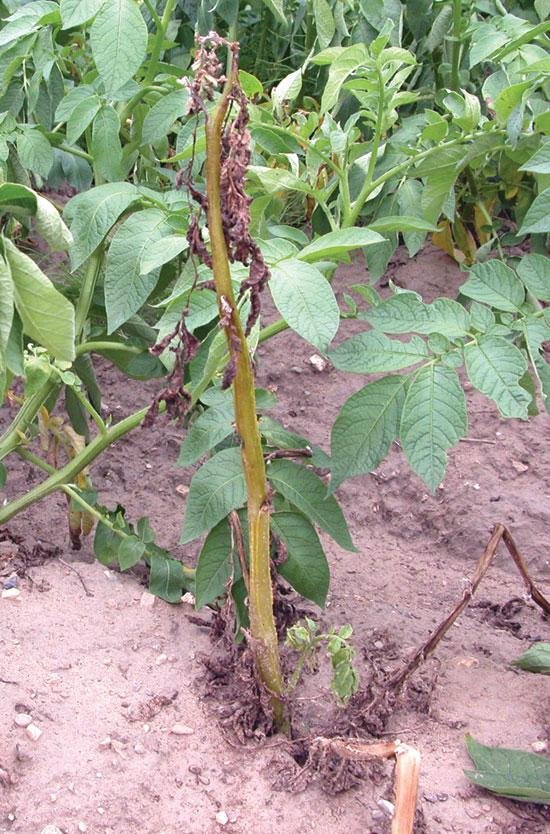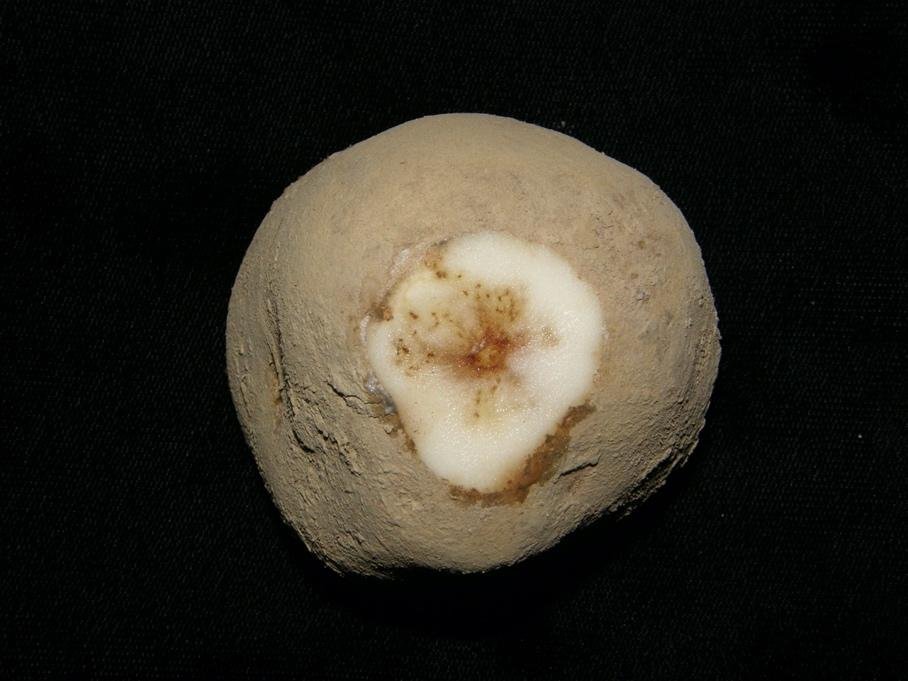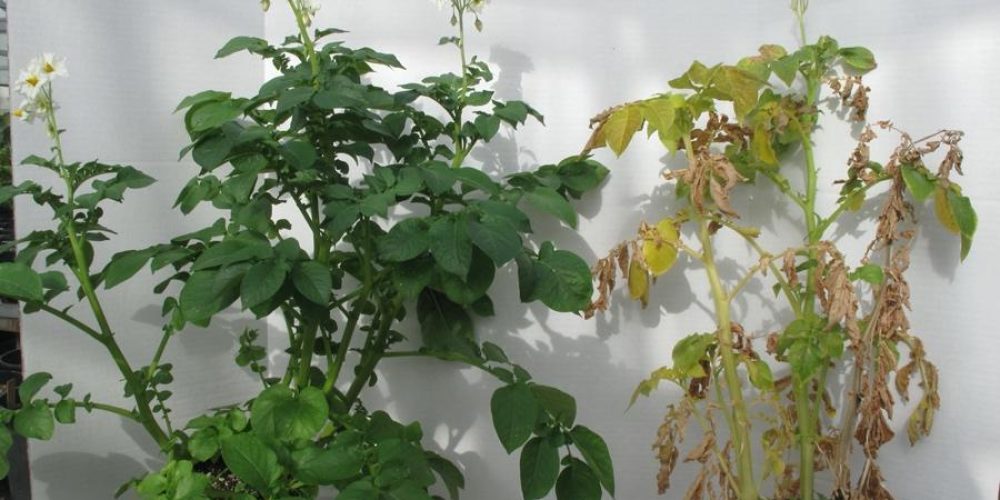Table of contents of the article
ToggleVerticillium wilt is a fungal disease that causes yellowing and wilting of potato stems and leaves, affecting production quality. This article from the “WORLD OF PLANTS” website provides an explanation of the symptoms of Verticillium wilt disease on potato stems and leaves and methods of prevention.
Introduction to Verticillium wilt disease on potato stems and leaves
Name of the disease: Potato verticillium wilt
Scientific name: Verticillium dahlia
Type of disease: Vascular wilting
Fungal family: Plectosphaerellaceae
Potatoes are susceptible to various diseases, and one such disease that can greatly affect their health and production is Verticillium wilt. This devastating disease is caused by the soil fungus Verticillium dahlia, which infects the vascular system of the potato plant, disrupting the transport of water and nutrients.

Life cycle of Verticillium wilt disease on potato stems and leaves
The life cycle of Verticillium Dahlia involves survival as resistant structures in the soil. These structures, known as microsclerotia, can persist for several years in the absence of a suitable host. Upon encountering a susceptible host, the fungus germinates and infects the plant through the roots. The fungus then colonizes the vascular system, causing wilting and other symptoms.

Symptoms of Verticillium wilt disease on potato stems and leaves
Potato plants infected with Verticillium wilt exhibit a range of symptoms that progress from mild early signs to advanced and distinct signs, providing growers with valuable clues for diagnosing and managing the disease.
1. Early symptoms
In the initial stages of Verticillium wilt, growers may notice subtle changes in the lower leaves of potato plants. The most common early symptoms include gradual yellowing of leaves and the beginning of wilting. Lower leaves, especially those closest to the soil, may show signs of reduced fullness and overall vigor. In addition, infected plants may exhibit faltering growth, with a noticeable decline in overall health.
2. Advanced symptoms
As the infection progresses, more severe symptoms appear affecting different parts of the potato plant. Vessel tissue in stems may undergo brown discoloration, indicating fungal colonization of the plant's vessels. Leaves and stems may undergo necrosis, resulting in dark, dead tissue. Premature defoliation, where leaves fall before reaching full maturity, is another advanced symptom. Together, these signs contribute to reducing the plant's ability to photosynthesize and overall vigor.
3. Characteristic symptoms
Characteristic features of Verticillium wilt include specific characteristics that help confirm the presence of the parasite. When cutting the stems, growers may notice discoloration of the vessels, revealing the effect Verticillium dahlia has on the internal structures of the plant. Another unique indicator is the presence of lesions on the surface of the tuber in a “V” shape. These lesions, often found during post-harvest inspection, are a diagnostic feature that distinguishes Verticillium wilt from other potato diseases. Recognizing these characteristic symptoms is vital for timely implementation of preventive measures.



Favorite conditions for Verticillium wilt on potato stems and leaves
- Season preferences: Verticillium wilt is preferred at moderate temperatures, usually between (21-24) °C in many areas, coinciding with late spring and summer.
- Soil Conditions: Well-drained soil with a pH range of 6.0 to 7.0.
- Environment Preferences – Greenhouses vs. Open Fields: Greenhouse environments with high humidity can facilitate the spread of Verticillium dahlia in greenhouses. Also, conditions in open fields are also favorable, especially in areas with suitable temperatures.
Causes of Verticillium wilt disease on potato stems and leaves
Several factors contribute to the spread of Verticillium wilt in potato crops.
- Contaminated soil: The presence of Verticillium dahlia in the soil, whether from previous potato crops or other susceptible hosts, can lead to the onset of the disease.
- Long periods between crop rotations: Extended periods between potato crops in the same field increase the risk of persistence of soil parasites such as Verticillium dahlia.
- Infected plant remains: Infected potato plant remains can be a source of the pathogen for the following crops.
Losses caused by Verticillium wilt on potato stems and leaves
Verticillium wilt infection can lead to significant production losses and negative effects on potato quality.
• Reduced tuber size: Injury hinders water and nutrient transport, negatively affecting tuber development and resulting in smaller potato size.
• Low productivity: wilting and premature defoliation contribute to a reduced ability to photosynthesize, resulting in a decrease in overall production.
Strategy to control Verticillium wilt disease on potato stems and leaves
certainly! Let's delve deeper into the Verticillium wilt control strategy, dividing it into three main areas: agricultural practices, chemical control, and organic control.
A. Agricultural practices
Agricultural practices play a vital role in the control of Verticillium wilt, as they aim to create an unfavorable environment for the parasite to survive and spread.
Examples:
- Crop rotation: Rotate potatoes with non-host crops to break the disease cycle. Choose crops that are not susceptible to Verticillium dahlia, which reduces the parasite's reproduction in the soil.
- Diverse crop sequence: Implement a varied crop sequence to avoid continuous planting of one crop, which prevents the buildup of Verticillium dahlia in the soil.
- Cleanliness: Quickly remove and destroy infected plant remains. This reduces the possibility of plant debris being a source of the pathogen in subsequent seasons.
B Chemical control
Fungicides can be used as part of an integrative management strategy to mitigate the impact of Verticillium wilt.
Examples:
- Soil fumigation: Chemicals such as chloropicrin or metam sodium can be used as soil fumigants before planting to reduce the buildup of Verticillium dahlia in the soil.
- Foliicides: Some fungicides, such as azoxystrobin, propiconazole, and thiophanate methyl, may be used during the growth period. Consult local agricultural extension offices for specific recommendations based on regional conditions.
C. Anti-organic
Organic control methods focus on biological agents and agricultural practices that reduce the effects of Verticillium wilt without the use of synthetic chemicals.
Examples:
- Biofumigation: Grow biofumigation crops like mustard or watercress in rotation. These plants release compounds as they decompose that inhibit soil parasites, including Verticillium dahlia.
- Vital enemies: Beneficial organisms such as Trichoderma spp. and Bacillus spp. On the soil. These parasite-fighting organisms compete with the parasite itself for resources and produce compounds that inhibit its growth.
- Compost Amendments: Microbial diversity can be improved by applying well-rotted compost, which may create a less favorable environment for Verticillium dahlia.
Integrated approach
A comprehensive strategy often includes integrating elements from each category to create a comprehensive management plan tailored to the particular farming conditions.
Example: Integrated Pest Management (IPM): Implementing IPM involves using a combination of cultural practices, chemical treatments when necessary, and biological enemies. Monitoring the system regularly and adjusting the strategy based on plant growth stage and disease pressure contributes to a more effective and sustainable approach.
By incorporating these measures into their potato growing practices, farmers can enhance the resilience of their crops against Verticillium wilt, promoting a healthy and productive harvest.
Preventive measures for Verticillium wilt on potato stems and leaves
Effective prevention is crucial to mitigate the risk of potato crops being infected with Verticillium wilt.
- Soil testing: Regularly check the soil for the presence of Verticillium dahlia and adjust control practices according to the results.
- Crop Rotation: Implement a diverse crop rotation to break the disease cycle and reduce parasite persistence.
- Resistant Rootstocks: Use rootstock modified potato varieties on resistant rootstocks to achieve improved protection.
- Surveillance and early detection: Monitor crops regularly to detect symptoms, and remove and destroy infected plants quickly to reduce the spread of the disease.
- Biointervention: Incorporation of biofumigation crops like mustard can help in reducing the level of parasites in the soil.
By integrating these preventive measures with agronomic and chemical practices, farmers can develop a comprehensive strategy to combat Verticillium wilt, ensuring the health and productivity of their potato crops.
Conclusion
Verticillium wilt, caused by Verticillium dahlia, poses a major threat to potato crops globally. With a comprehensive understanding of its life cycle, symptoms and favorable conditions, farmers can implement targeted measures to protect their crops. Also, individuals in the agricultural sector must continue to share information, enhance cooperation, and empower farmers to combat plant diseases, to ensure a sustainable and productive future for potato farming.
In conclusion, we would like to note that we, at the world of plants website, offer you all the necessary services in the world of plants, we provide all farmers and those interested in plants with three main services::-
- Artificial intelligence consulting service to help you identify diseases that affect plants and how to deal with them.
- Blog about plants, plant diseases and care of various crops ... You are currently browsing one of her articles right now.
- An application that provides agricultural consultations to clients, as well as a service for imaging diseases and knowing their treatment for free – Click to download the Android version from Google Play Store، Click to download the IOS version from the Apple App Store.
Sources:
Agrios, G. N. (2005). Plant Pathology. Elsevier Academic Press.
Compendium of Ornamental Foliage Plant Diseases. (1998). APS Press.
3Verticillium Wilt of Potato – A Comprehensive Guide. (2012). American Phytopathological Society.
4Verticillium dahliae: A Review of Its Pathogenicity, Resistance Mechanisms, and Control. (2017). Frontiers in Microbiology.
Toth, I. K., van der Wolf, J. M., Saddler, G., Lojkowska, E., & Hélias, V. (2011). Chapter Five – Verticillium dahliae: Potato Wilt. Advances in Applied Microbiology, 76, 41-61.
Plantix – Verticillium Wilt of Potato
Crop Protection Compendium. (2020). CABI.





2 Comments
I am from Afghanistan, I am very poor in terms of finances but very rich in terms of science, when I was introduced to your site, I learned a lot about plant diseases which is my specialty, I am very grateful to you for You have done such a humanitarian service and you are leading the people of the world towards awareness and you have turned the world into a small village, science enthusiasts anywhere in the world can use this site more easily.
In the end, I would like to suggest that if you add PowerPoint creation for free on this site, there will be many interested.
thanks
your friend
Sarwar Mohammadi – Afghanistan – Bamiyan
8/12/2024
Dear Sarwar Mohammadi,
Thank you for your heartfelt message. We are truly moved by your words and are honored to know that our platform has been helpful to you in your scientific endeavors. It is inspiring to hear from dedicated individuals like yourself, who are rich in knowledge and passion, despite their challenges.
Your suggestion to add a free PowerPoint creation feature is valuable, and we will consider it as we continue to improve our platform. It’s feedback like yours that helps us grow and better serve users around the world.
Warm regards,
The World of Plants team